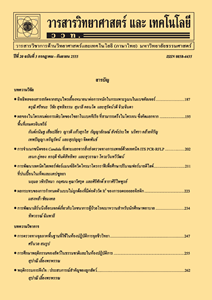การจำแนกพื้นที่ปลูกพืชเศรษฐกิจจากข้อมูลภาพดาวเทียมแลนด์แซท 8 และข้อมูลทุติยภูมิโดยวิธีซัพพอร์ตเวกเตอร์แมทชีนในพื้นที่ลุ่มน้ำลำเชียงไกรตอนบน
Main Article Content
Abstract
The aim of the study is to develop economic crop areas classification method from Landsat 8 using combined datasets of spectral data and ancillary data including (1) Tasseled cap calculation data of Landsat 8 (brightness, greenness, and wetness) and (2) Biophysical data (elevation, slope, and aspect) for increasing the accuracy of economic crops classification using support vector machine method in Upper Lamchiengkrai watershed of Nakhon Ratchasima province (the top three main economic crops of Nakhon Ratchasima province). The Landsat 8 images with the ancillary data were classified into seven LULC types that consisted of (1) urban and built-up area, (2) economic crops (e.g. paddy field, maize, cassava and sugarcane), (3) tree and orchard, (4) forest land, (5) water body, (6) scrub and (7) bare land. In addition, the accuracy assessment of the economic crops classification was performed by using the overall accuracy and kappa coefficient to find the optimum groups of the dataset. The result revealed that the overall accuracies and the kappa hat coefficients of various groups of the datasets were 84.21-92.76 and 62.35-81.67 %, respectively and the most optimum group for the economic crops classification is the integration of spectral data, brightness, greenness, wetness, and elevation. As a result, applying spectral data with the ancillary data of Tasseled cap data and some biophysical data can increase the accuracy of the economic crops classification.
Article Details
References
The Secretariat of the Cabinet, Water Resources Management in Upstream Areas, Available Source: https://www.soc.go.th/acrobat/nesac070952_1, August 19, 2017. (in Thai)
Sangawong, S., 2009, Remote Sensing of Land Use and Land Cover and Application, 1st Ed., Chulalongkorn Press, Bangkok, 280 p.
Paengwangthong, W., 2018, Classification of deciduous forest area using multitemporal Landsat imageries with band ratio techniques, Thammasat Int. J. Sci. Tech. 26(8): 1302-1310.
Burges, C.J.C., 1998, A tutorial on support vector machines for pattern recognition, Data Min. Knowl. Discov. 2: 121-167.
Ninh, T.V., and Waisurasingha, C., 2017, A comparative study of applying maximum likelihood and support vector machine classifiers to analyze Landsat imagery for evaluating land use changes in Khon Kaen city, Thailand, KKU Res. J. (Grad. Stud.) 17(4): 49-60. (in Thai)
Bahari, N.I.S., Ahmad, A. and Aboobaider, M., 2014, Application of support vector machine for classification of multispectral data, Earth Environ. Sci. 20(2014): 012038.
Taufik, A., Ahmad, S.S.S. and Ahmad, A., 2016, Classification of Landsat 8 satellite data using NDVI thresholds, J. Telecommun. Electron. Comput. Eng. 8(4): 37-40.
Faust, N.L., 1989, Image Enhancement, Volume 20, In Kent, A. and Williams, J.G. (Eds.), Supplement 5 of Encyclopedia of Computer Science and Technology, Marcel Dekker, Inc., New York.
Ongsomwang, S., 2016, Remote Sensing Systems and Digital Image Analysis, Handout, School of Remote Sensing, Institute of Science, Suranaree University of Technology, Nakorn Ratchasima, 1009 p. (in Thai)
Tessawat, W., 2011, A Comparative Accuracy Assessment of Expert Systems and Artificial Neural Network Classification Methods for Identification of Cassava and Sugarcane Areas using Theos Data, Master Thesis, Suranaree University of Techno logy, Nakorn Ratchasima.
U.S. Geological Survey, 2017, Band Designations for Landsat Satellites, Available Source: https://landsat.usgs.gov/what-are-band-designations-landsat-satellites, August 19, 2017.
Yale, 2019, Tasseled Cap Transform for Landsat (8) OLI, Available Source: https://yceo.yale.edu/tasseled-cap-transform-landsat-8-oli. June 19, 2017.
Congalton, R.G. and Green, K., 1999, Assessing the Accuracy of Remotely Sensed Data: Principles and Practices, Lewis Publishers, Boca Raton, FL., 137 p.


